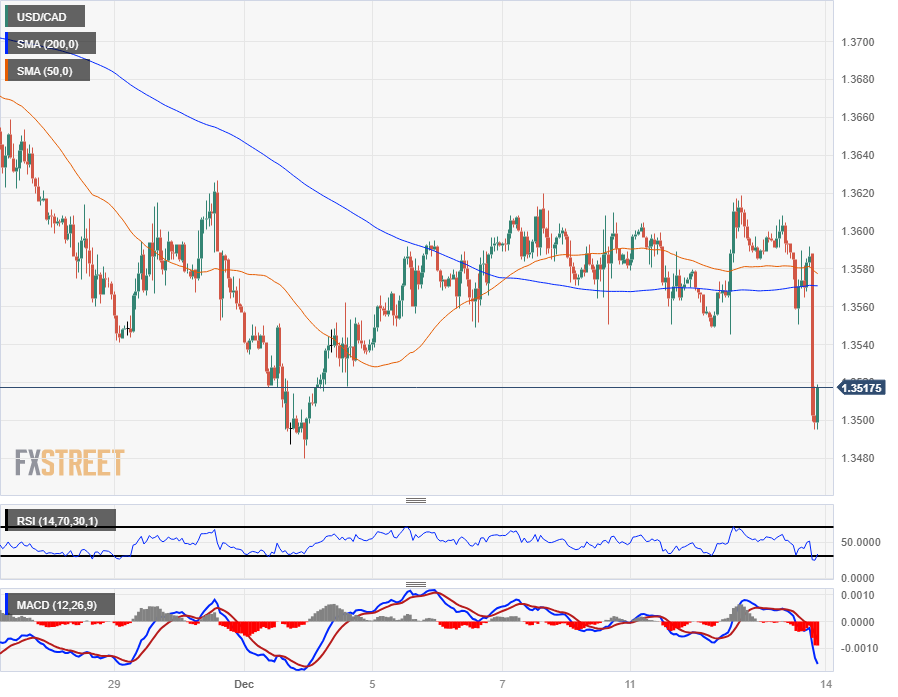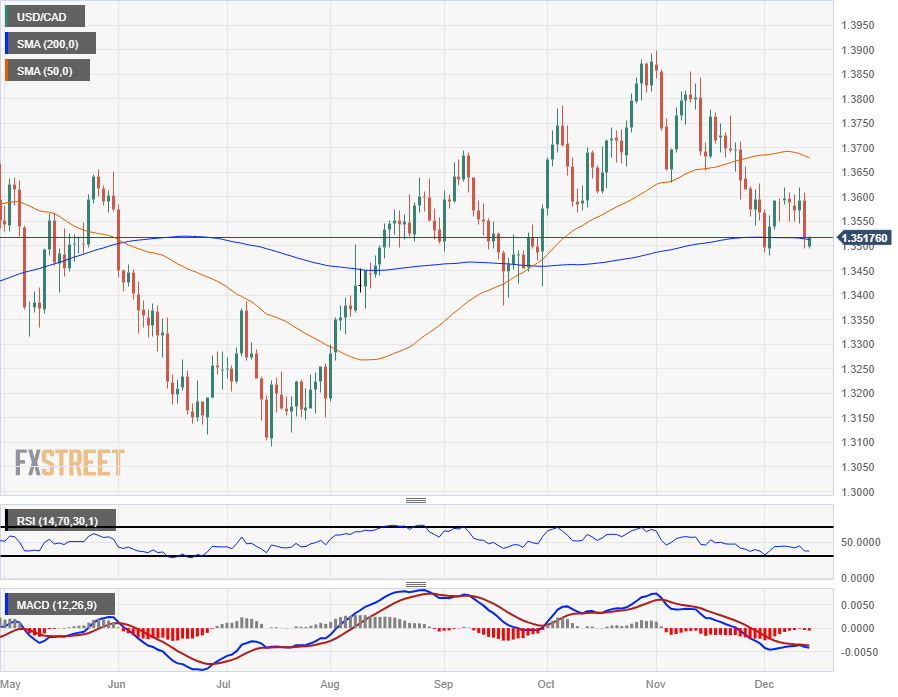Most recent article: Canadian Dollar extends gains as WTI Crude Oil rebounds
- Canadian Dollar rides a risk-on wave after Fed cuts rate expectations.
- FOMC's updated dot plot sees three cuts for 75 basis points in rate cuts in 2024.
- CAD catches a supporting bid from rising Crude Oil, WTI bounces from new lows.
The Canadian Dollar (CAD) was well-bid against the US Dollar (USD) on Wednesday, gaining additional support from a thin but noticeable relief rally in Crude Oil markets. The Federal Reserve (Fed) slashed its Interest Rate Expectations for 2024, and Fed policymakers see at least three rate cuts in 2024, for a combined 75 basis points in cuts for next year's interest rate.
The Canadian economic calendar remains tepid this week; Loonie traders will be forced to wait until Bank of Canada (BoC) Governor Tiff Macklem’s appearance late Friday before the CAD finds tradeable headlines from behind home plate.
With the Fed's rate statement out of the way and the FOMC holding rates at 5.5% for the last meeting of the year, forecasting accelerated rate cuts looking forward, markets will be focusing on Fed Chairman Jerome Powell's press conference, due 30 minutes after the Fed's rate statement.
Daily Digest Market Movers: Canadian Dollar grinds through frothy markets ahead of Fed rate call
- Despite the Canadian Dollar’s Crude Oil-fueled bid on Wednesday, the Fed is stealing the limelight, and it was all eyes on Powell for the mid-week market session.
- The Federal Reserve held rates at 5.5% for the third straight FOMC meeting, its longest holding pattern since the most recent rate hike cycle began in early 2022.
- Investors are broadly anticipating an accelerated path toward more frequent rate cuts next year.
- Markets are anticipating rate cuts to begin as soon as the first quarter of 2024, and investor expectations of easing rates may have run well ahead of what the Fed considers achievable.
- With Fed Chair Powell scrapping forward guidance last year, Fed rate statements have an outsized market impact as the US central bank assesses data on a case-by-case basis.
- Crude Oil markets sank to fresh lows this week, with West Texas Intermediate (WTI) sagging into $68 per barrel early Wednesday before catching a near-term relief rally back toward $70.
- The Canadian Dollar is latching onto the rebound in Crude Oil to squeeze out a gain against the US Dollar (USD), climbing half of a percent against the Greenback as markets see a broad risk bid.
Canadian Dollar price today
The table below shows the percentage change of Canadian Dollar (CAD) against listed major currencies today. Canadian Dollar was the strongest against the US Dollar.
| USD | EUR | GBP | CAD | AUD | JPY | NZD | CHF | |
| USD | -0.71% | -0.39% | -0.51% | -1.46% | -1.67% | -0.62% | -0.40% | |
| EUR | 0.70% | 0.32% | 0.20% | -0.75% | -0.95% | 0.10% | 0.30% | |
| GBP | 0.37% | -0.33% | -0.13% | -1.07% | -1.28% | -0.24% | -0.03% | |
| CAD | 0.50% | -0.21% | 0.12% | -0.96% | -1.15% | -0.12% | 0.08% | |
| AUD | 1.46% | 0.74% | 1.05% | 0.96% | -0.21% | 0.82% | 1.04% | |
| JPY | 1.65% | 0.93% | 1.26% | 1.13% | 0.15% | 1.03% | 1.24% | |
| NZD | 0.61% | -0.10% | 0.23% | 0.13% | -0.83% | -1.09% | 0.21% | |
| CHF | 0.40% | -0.31% | 0.02% | -0.10% | -1.07% | -1.26% | -0.22% |
The heat map shows percentage changes of major currencies against each other. The base currency is picked from the left column, while the quote currency is picked from the top row. For example, if you pick the Euro from the left column and move along the horizontal line to the Japanese Yen, the percentage change displayed in the box will represent EUR (base)/JPY (quote).
Technical Analysis: Canadian Dollar cracks through the bottom end of consolidation to retest 1.3500
The Canadian Dollar (CAD) saw choppy trading forming into a near-term sideways channel against the US Dollar (USD), keeping the USD/CAD capped between 1.3610 and 1.3550 before Wednesday's blowout Fed showing sent the pair back into the 1.3500 handle. Intraday action has turned firmly bearish, sending the pair tumbling clean through the 200-hour Simple Moving Average (SMA) near 1.3570.
A bounce from the 200-day SMA for the USD/CAD at the start of December has failed to crystallize into a meaningful bullish recovery, keeping the pair constrained in a congestion zone just beneath the 1.3600 handle. The pair is now falling back into the 200-day SMA.
The US Dollar is down two-and-a-third percent against the Canadian Dollar after dropping from December’s early high of 1.3899 and making a clean shear of the 50-day SMA just below 1.3700.
Fundamentals are going to drive the USD/CAD on Wednesday, and technical traders will need to be mindful that technical barriers could easily evaporate, depending on how investors digest the day’s headlines.
USD/CAD Hourly Chart

USD/CAD Daily Chart

Canadian Dollar FAQs
What key factors drive the Canadian Dollar?
The key factors driving the Canadian Dollar (CAD) are the level of interest rates set by the Bank of Canada (BoC), the price of Oil, Canada’s largest export, the health of its economy, inflation and the Trade Balance, which is the difference between the value of Canada’s exports versus its imports. Other factors include market sentiment – whether investors are taking on more risky assets (risk-on) or seeking safe-havens (risk-off) – with risk-on being CAD-positive. As its largest trading partner, the health of the US economy is also a key factor influencing the Canadian Dollar.
How do the decisions of the Bank of Canada impact the Canadian Dollar?
The Bank of Canada (BoC) has a significant influence on the Canadian Dollar by setting the level of interest rates that banks can lend to one another. This influences the level of interest rates for everyone. The main goal of the BoC is to maintain inflation at 1-3% by adjusting interest rates up or down. Relatively higher interest rates tend to be positive for the CAD. The Bank of Canada can also use quantitative easing and tightening to influence credit conditions, with the former CAD-negative and the latter CAD-positive.
How does the price of Oil impact the Canadian Dollar?
The price of Oil is a key factor impacting the value of the Canadian Dollar. Petroleum is Canada’s biggest export, so Oil price tends to have an immediate impact on the CAD value. Generally, if Oil price rises CAD also goes up, as aggregate demand for the currency increases. The opposite is the case if the price of Oil falls. Higher Oil prices also tend to result in a greater likelihood of a positive Trade Balance, which is also supportive of the CAD.
How does inflation data impact the value of the Canadian Dollar?
While inflation had always traditionally been thought of as a negative factor for a currency since it lowers the value of money, the opposite has actually been the case in modern times with the relaxation of cross-border capital controls. Higher inflation tends to lead central banks to put up interest rates which attracts more capital inflows from global investors seeking a lucrative place to keep their money. This increases demand for the local currency, which in Canada’s case is the Canadian Dollar.
How does economic data influence the value of the Canadian Dollar?
Macroeconomic data releases gauge the health of the economy and can have an impact on the Canadian Dollar. Indicators such as GDP, Manufacturing and Services PMIs, employment, and consumer sentiment surveys can all influence the direction of the CAD. A strong economy is good for the Canadian Dollar. Not only does it attract more foreign investment but it may encourage the Bank of Canada to put up interest rates, leading to a stronger currency. If economic data is weak, however, the CAD is likely to fall.
Information on these pages contains forward-looking statements that involve risks and uncertainties. Markets and instruments profiled on this page are for informational purposes only and should not in any way come across as a recommendation to buy or sell in these assets. You should do your own thorough research before making any investment decisions. FXStreet does not in any way guarantee that this information is free from mistakes, errors, or material misstatements. It also does not guarantee that this information is of a timely nature. Investing in Open Markets involves a great deal of risk, including the loss of all or a portion of your investment, as well as emotional distress. All risks, losses and costs associated with investing, including total loss of principal, are your responsibility. The views and opinions expressed in this article are those of the authors and do not necessarily reflect the official policy or position of FXStreet nor its advertisers. The author will not be held responsible for information that is found at the end of links posted on this page.
If not otherwise explicitly mentioned in the body of the article, at the time of writing, the author has no position in any stock mentioned in this article and no business relationship with any company mentioned. The author has not received compensation for writing this article, other than from FXStreet.
FXStreet and the author do not provide personalized recommendations. The author makes no representations as to the accuracy, completeness, or suitability of this information. FXStreet and the author will not be liable for any errors, omissions or any losses, injuries or damages arising from this information and its display or use. Errors and omissions excepted.
The author and FXStreet are not registered investment advisors and nothing in this article is intended to be investment advice.
Recommended content
Editors’ Picks

AUD/USD clings to recovery gains below 0.6550 on weaker USD, upbeat mood
AUD/USD holds sizeable gains below 0.6550 in the Asian session on Monday. A sharp pullback in the US bond yields prompts some US Dollar profit-taking after US President-elect Trump named Scott Bessent as Treasury Chief. Moreover, the upbeat market mood supports the risk-sensitive Aussie.

USD/JPY trims losses to regain 154.00 as USD sellers pause
USD/JPY trims losses to retest 154.00 in the Asian session on Monday. Retreating US Treasury bond yields drags the US Dollar away from a two-year top high and drives flows towards the lower-yielding Japanese Yen, though the BoJ uncertainty could limit losses for the pair.

Gold: Is the tide turning in favor of XAU/USD sellers?
After witnessing intense volatility in Monday's opening hour, Gold's price is licking its wounds near $2,700. The bright metal enjoyed good two-way trades before sellers returned to the game after five straight days.

Elections, inflation, and the bond market

Eurozone PMI sounds the alarm about growth once more
The composite PMI dropped from 50 to 48.1, once more stressing growth concerns for the eurozone. Hard data has actually come in better than expected recently – so ahead of the December meeting, the ECB has to figure out whether this is the PMI crying wolf or whether it should take this signal seriously. We think it’s the latter.

Best Forex Brokers with Low Spreads
VERIFIED Low spreads are crucial for reducing trading costs. Explore top Forex brokers offering competitive spreads and high leverage. Compare options for EUR/USD, GBP/USD, USD/JPY, and Gold.